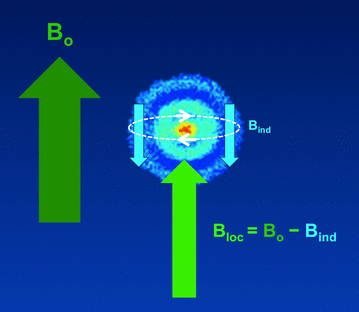|
Chemical shifts result from diamagnetic susceptibility effects at the atomic/molecular level. Susceptibility is a response of matter to an external magnetic field that may arise from several different mechanisms (described in a prior Q&A). The easiest way to think about the phenomenon is to imagine that the electrons circulating around the nucleus produce an "induced" magnetic field (Bind) that opposes Bo. The electron cloud thus acts as a "shield" to protect the nucleus from the full force of Bo. The shielding factor is commonly given the symbol σ, where Bind = σBo. The local effective field experienced by the nucleus is therefore Bloc, where
Bloc = Bo − Bind = Bo (1 − σ)
|
The frequency difference (fsamp − fref ) is usually on the order of a few hundred to a few thousand Hz, while the reference frequency (fref ) is measured in MHz. The chemical shift (δ) is therefore a small number, expressed in units of parts per million (ppm). The suffix ppm is interchangeable with x10 −6, just as the symbol % is interchangeable with x0.01 or x10−2.
The chemical shift (δ) is a dimensionless constant specific for each type of nucleus (¹H, ³²P, etc) and chemical configuration (—CH3, —OH, --PO4, etc). Tables of chemical shift values are readily available (now embedded into computer/smart phone applications) allowing chemists rapid identification of detected nuclei in MRS experiments.
Advanced Discussion (show/hide)»
Click on the button to go to a hidden advanced page!
Proctor WG, Yu FC. The dependence of a nuclear magnetic resonance frequency upon chemical compound. Phys Rev 1950; 77:717. (This is the famous paper where changes in resonance frequency — later to be known as "chemical shifts" — were first reported among several nitrogen compounds, the basis for NMR spectroscopy).
Harris RK, Becker ED, Cabral de Menezes SM, et al. NMR Nomenclature. Nuclear Spin Properties and Conventions for Chemical Shifts (IUPAC Recommendations 2001). Pure Appl Chem 2001; 73:1795-1818.
Harris RK, Becker ED, Cabral de Menezes SM, et al. Further conventions for NMR shielding and chemical shifts (IUPAC recommendations 2008). Pure Appl Chem 2008; 80:59-84.
|
© 2024 AD Elster, ELSTER LLC
All rights reserved. |
|

